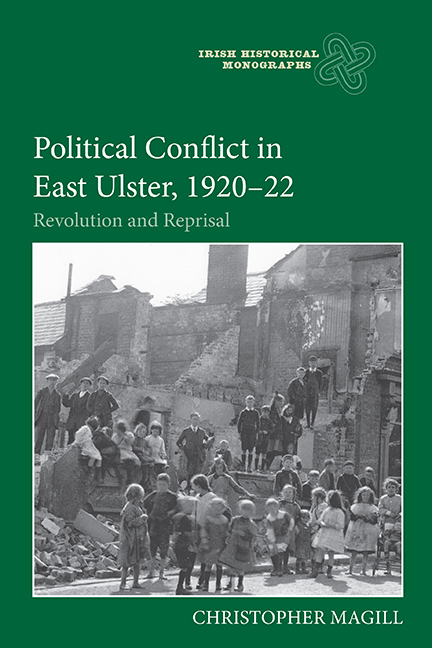Book contents
- Frontmatter
- Dedication
- Contents
- List of Illustrations
- Acknowledgements
- Abbreviations
- A Note on Terminology
- Map
- ‘Cork Justice Travelled a Long Way’: the Assassination of District Inspector Oswald Swanzy
- 1 From Moderates to Militants: the Unionist Community in East Ulster
- 2 Reprisal: the East Ulster Riots
- 3 ‘A Vital But Unenviable Task’: Understanding Loyalist Violence
- 4 A Protestant Force: the Social Composition of the B Specials
- 5 The Wilder the Better? Explaining the Violence of the Ulster Special Constabulary
- 6 A Misunderstood Minority: Irish Nationalists
- Conclusion
- Bibliography
- Index
- Irish Historical Monographs Previous Volumes
1 - From Moderates to Militants: the Unionist Community in East Ulster
Published online by Cambridge University Press: 21 October 2020
- Frontmatter
- Dedication
- Contents
- List of Illustrations
- Acknowledgements
- Abbreviations
- A Note on Terminology
- Map
- ‘Cork Justice Travelled a Long Way’: the Assassination of District Inspector Oswald Swanzy
- 1 From Moderates to Militants: the Unionist Community in East Ulster
- 2 Reprisal: the East Ulster Riots
- 3 ‘A Vital But Unenviable Task’: Understanding Loyalist Violence
- 4 A Protestant Force: the Social Composition of the B Specials
- 5 The Wilder the Better? Explaining the Violence of the Ulster Special Constabulary
- 6 A Misunderstood Minority: Irish Nationalists
- Conclusion
- Bibliography
- Index
- Irish Historical Monographs Previous Volumes
Summary
I
The first guns of the Irish revolutionary period arrived in east Ulster. In late April 1914 a consignment of 25,000 rifles and three million rounds of ammunition was landed in Larne, Donaghadee and Bangor for use by the UVF. This dramatic event signalled the beginning of the militarisation of Irish politics, a watershed moment following decades of constitutional battles over Home Rule. On two occasions Irish nationalists had seen Home Rule bills rejected in parliament – once, in 1886, by the Commons and again, in 1893, by the Lords – resulting in no greater response than occasional riots and smallscale unionist drilling. But, in 1912, the political landscape was fundamentally altered. The British government introduced a third Home Rule bill in April, the result of the achievement of the constitutional nationalist Irish Parliamentary Party in winning the balance of power in Westminster. John Redmond, the Irish Party leader, accepted Herbert Asquith's invitation to support his Liberal government in return for a Liberal commitment to implement Home Rule. With Liberal support for an Irish parliament, and following the removal in 1911 of the power of the Lords to permanently veto legislation, unionists now saw no way of blocking Home Rule that did not involve direct action on their part. The numerical weakness of unionists in southern Ireland made resistance there futile, so it was in Ulster that unionist mobilisation was concentrated.
The rapidity and effectiveness with which Ulster unionists organised themselves reflected their commitment to the Union. It was particularly impressive given their previously poor organisation in the region. Factors driving that response ranged from their commitment to a British identity, to the fear that Home Rule would harm Ulster industry and a desire to preserve their civil and religious liberties. Plain bigotry also figured: there was a genuine belief among some that Catholic majority rule was ‘a perversion of nature’.
The result was a cross-class alliance of tenant farmers, landlords, industrial workers, business leaders and social elites, a convergence facilitated by the Ulster Unionist Council (UUC) which represented their collective views. The Conservative Party threw its weight behind the unionist movement, with its leader Andrew Bonar Law going so far as to proclaim recklessly that ‘there are things stronger than parliamentary majorities’.
- Type
- Chapter
- Information
- Political Conflict in East Ulster, 1920–22Revolution and Reprisal, pp. 17 - 38Publisher: Boydell & BrewerPrint publication year: 2020

